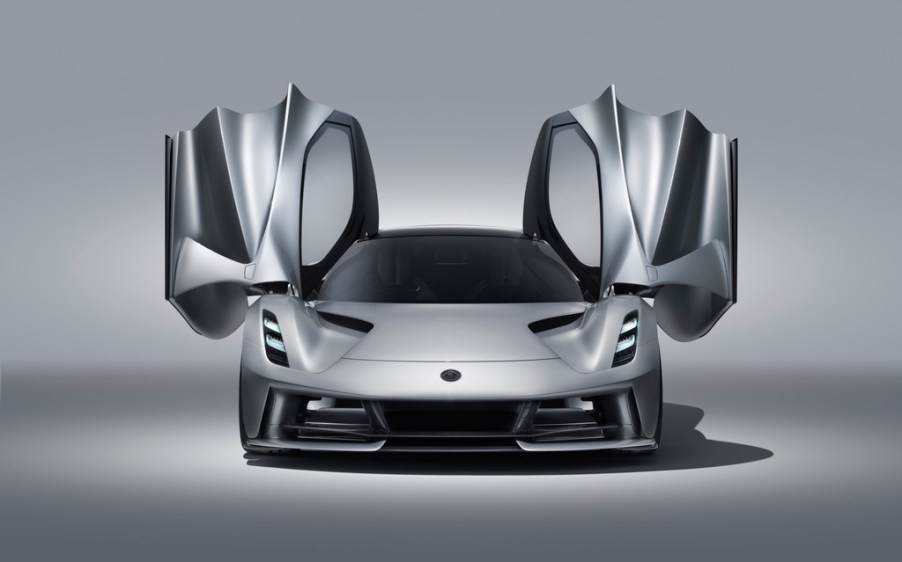
The Lotus Evija Is a Near-2,000-hp Electric Hypercar
In London on July 19, 2019, Lotus Cars introduced the world’s most powerful series-production car, the 2021 Evija. It also happens to be Britain’s first purely electric car. While these two facts seem somehow contradictory, this supercar is targeted to make a jaw-dropping 1,970 hp and 1,254 lb-ft of torque powered by a 70 kWh lithium-ion battery.
The story of a high achiever

The Evija, whose name is taken from the Hebrew word that means “living”, is Lotus’ first hypercar. At just over 3,700 pounds, the car is also one of the lightest long-range electric cars ever. Given all of the Evija’s achievements, it’s no wonder that Lotus has made the Evija its halo car for the rest of the Lotus lineup which includes the Elise, the Exige, and the Evora.
The electric hypercar is the first new vehicle to be produced by Lotus under the direction of its parent company Geely, a global automotive group based in China. Lotus has designated the Evija the Type 130 in reference to the number of the cars that will be made. Production begins in 2020 at the Lotus factory in Hethel, U.K., and prospective buyers should look for a price tag of over $2 million.
Mind-boggling speed
With nearly 2,000 hp, it’s not surprising that the Evija can reach a top speed of 200 mph. It accelerates from 0 to 62 miles per hour in under 3.0 seconds and from 0 to 186 in less than 9.0 seconds. The new Lotus also shines at acceleration at higher speeds, clocking from 62 to 124 mph in under 3.0 seconds and from 124 to 186 in under 4.0 seconds.
A front runner among the big players

Another distinction for the Evija is that it is the first electric hypercar to be offered by a traditional sports car manufacturer. The Evija’s best-known rival will be Tesla’s 2020 Roadster. Lotus will also be competing with lesser-known manufacturers such as China’s NIO, Italy’s Pininfarina, Croatia’s Rimac, and Switzerland’s Piëch in this space.
According to Automotive News Europe, Porsche, Ferrari, McLaren, and Aston Martin have all held back from producing an electric sports car because of concerns about overly fast battery drain caused by the car’s full-on performance. But Lotus apparently has solved this problem by making the electric powertrain system extremely efficient and using the car’s innovative aerodynamics and its four-radiator cooling system to keep battery operation optimal.
But the question remains: what is the secret behind the Evija’s extraordinary horsepower and torque?
Electrifying power

As counterintuitive as it seems, the 70-kWh battery pack is at the heart of it all—literally and figuratively. Lotus opted to position the battery mid-car behind the two-seater cabin because it provides better weight distribution, easier servicing, and the ability to swap out batteries when needed. The positioning also mirrors the other mid-engine cars in Lotus’ lineup.
Also, recharging the battery to 100% takes just 18 minutes, and the car has a range of pure electric driving of 250 miles.
The Evija’s battery capacity doesn’t seem like much, as compared to the massive 200-kWh battery that drives Tesla’s Roadster. In this case, bigger is not necessarily better, and a smaller battery means less weight and better performance. Moreover, Lotus’ innovative design trumps battery capacity because the relationship between the battery and the rest of the electric powertrain is much more important.
How the Evija’s electric powertrain works

The battery pack sends power to four independent electric motors located at each wheel. Each motor is rated at 493 hp and the four e-motors together generate the Evija’s amazing 1,970 hp and 1,254 lb-ft of torque. Lotus notes that there is more power at each wheel of the Evija than the power of any other road car that it has ever produced. It might be a marketing ploy, but the automaker goes on to state that the Evija is powerful enough to have defeated a team of four Evora Sport 410 supercars in a tug of war.
To transfer power to each driveshaft, Lotus utilizes four single-speed, helical gear ground planetary gearboxes. Planetary gearing provides high power for the car in a space-efficient way. And the e-motors enable torque-vectoring so that the torque sent by the differential to each wheel allows variability. This system helps to give the Evija better handling and agility by rapidly distributing power to any combination of two or more wheels.
An exceptional hypercar, but not for the U.S.
The Lotus Evija offers mind-blowing power and speed as well as innovative design with its all-electric powertrain, butterfly doors, and Venturi tunnels running through its rear fenders. Unfortunately, the pride of Lotus won’t be offered in the U.S. when it rolls off the production line. We’ll just have to hope that we’ll see the Evija stateside a few years from now.


